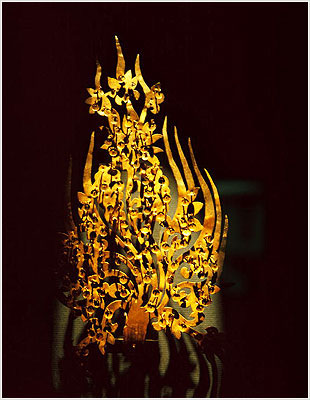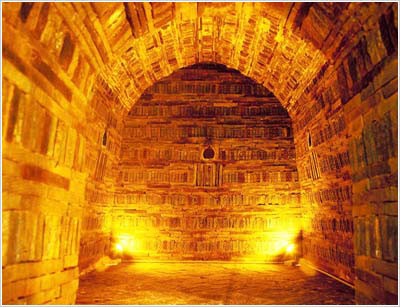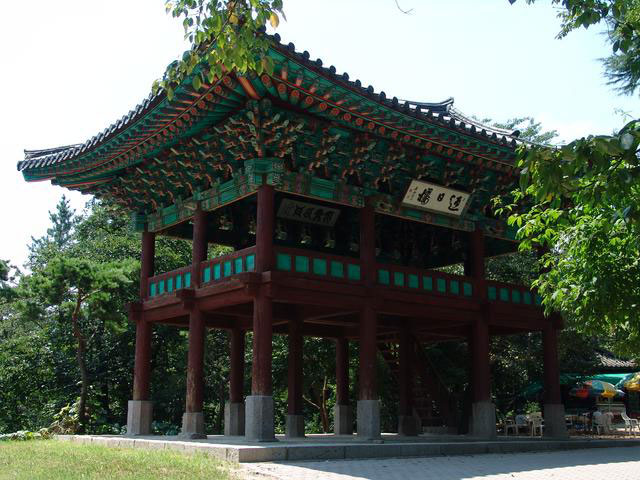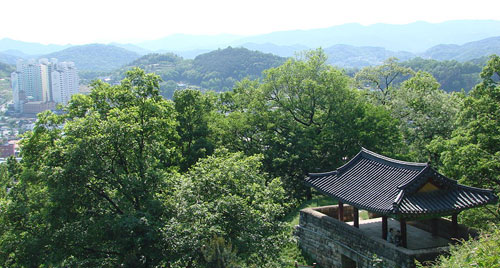Gongju National Museum

공주시
Gongju National Museum manages and preserves the cultural treasures excavated from northern Chungcheongnam-do. It takes special care of cultural treasures discovered from Muryeong Royal Tomb in 1971. The Muryeong Royal Tomb is the tomb of King Muryeong (501~523) and his queen consort from the Baekje Period.
You can view most of the relics from the Tomb at the museum. The current buildings were specifically built to exhibit those relics. Gonju Museum has excavated many other relics and sites.
The exhibit hall constitutes of 2 parts. It exhibits over 1000 relics, including National Treasure No.19 and No.4. The first room of the 2nd floor displays the relics from the Muryeong Tomb. It is quite a treat to view the golden belt, bracelet and bronze mirrors. There is even a full-scale model of the Muryeong Tomb for you to view.
The 2nd room of the first floor displays the relics from the Chungcheongnam-do area by chronology.
Outside in front of the main building is a garden where you can go to after the viewing inside the museum, and you can see many relics which were excavated from the whole Gongju district.
An eye-catching site is the two large stone bowls, used long ago to store water. Between the relics, there are dozens of golden pine, nut pine and cherry trees planted, which are over 70 years old.
It is an ideal place for visitors to rest. If you are looking for souvenirs, there is a Souvenir Shop where you will find many cute souvenirs.
Songsan-ri Ancient Tomb

Burial Mounds and Tomb of King Muryeong
The Songsan-ri Burial Mounds and Tomb of King Muryeong(reign 462-523) contains representative relics of the Baekje period (234~678). The Songsan-ri Burial Mounds have graves of kings from the period when Baekje’s capital was Gongju, and it is believed to contain 10 such graves. Only seven graves have been discovered so far.
The biggest attraction of Songsan-ri Burial Mounds is the wall painting drawn on the number 6 tomb – it is the only art of its kind in the world, drawn from the way the bricks were laid to create the wall. The tomb is shaped like a long tunnel, the top rounded like a dome. There are pictures of fire-breathing dragons on the tomb. Only the parts of the wall where the pictures were to be drawn had earth coated on, and on that earth was drawn Sasindo – the blue dragon, white tiger, red peacock, and black turtle.
The popular Tomb of King Muryeong is the 7th tomb, and it is the resting place for Baekje’s 25th King Mu-Ryeong and his Queen. This tomb was discovered accidentally when installing pipes to prevent tombs number 5 and 6 from being flooded. Tomb of King Muryeong was found to be unusual in the way it was built and what it contained. It was built with bricks like the 6th Tomb, and many national treasures were found inside, supplying scholars studying Baekje culture with precious research material. There were 108 kinds of artifacts found inside, totaling 2,906 items altogether. 12 of these artifacts were designated National Treasures. They are all on display at the Gongju National Museum. Some of the representative treasures are the crowns worn by the King and the Queen, gold decorations for the crowns, gold earrings, necklaces, bronze mirrors, pillows, and foot pillows. Recently the tomb was permanently sealed to protect the treasures. You can look at the miniature of the tomb, however, an exact duplicate of the original, in the basement of the Gobungun Building.
Buso Fortress

Gongju
Gongju (Gongju-si), also spelt Kongju, is a city in South Chungcheong province, South Korea.
Gongju was formerly named Ungjin and was the capital of Baekje from AD 475 to 538. In this period, Baekje was under threat from Goguryeo. Goguryeo had overrun the previous capital of Hanseong (modern-day Seoul), which forced Baekje to find a new center of strength.
In 538, King Seong moved the capital to Sabi (in modern-day Buyeo County). However, Gongju remained an important center until the kingdom’s fall in 667.

공주시
New capital
On August 11, 2004, the South Korean Prime Minister Lee Hae-chan announced that the country’s capital will be moved from Seoul to Gongju (approximately 120km south of Seoul) and Yeongi commencing in 2007. A 72.91 km² (18,016 acre) site was chosen for the project, which was scheduled to be completed by 2030. It was envisaged that government and administrative functions will move to the new capital, along with (possibly) the National Assembly and supreme court, although no sizable relocation was expected until the first phase of the project has been completed by 2012.
The move was intended to reduce Seoul’s overcrowding and economic dominance over the rest of South Korea; perhaps not coincidentally, it would have also moved the government and administration out of range of North Korean artillery fire.
The projected cost of the project ranged from $45bn to as much as $94bn.
The plan has aroused controversy, with opposition parties calling for a referendum to see whether it is endorsed by the population. Some civic groups have also launched a constitutional appeal, and on October 21, 2004, the Constitutional Court ruled that the special law for the relocation of the capital is unconstitutional since the relocation is a serious national matter requiring national referendum or revision of the constitution, thus effectively ending the dispute. Opinion polls showed that a slight majority of South Koreans are opposed to the move, both before and after the ruling.
However, late in 2004, the government announced yet another plan that will allow Seoul to be a capital in name only by retaining the Executive Branch in Seoul, while moving all other branches of government to Gongju. The question remains unresolved to date.[2]
Tourists’ sites
Tourist’s map in Gongju national museum
Gongju was a capital of Baekje, and was a provincial city governing Chungcheong provinice. So it has lots of good places to visit. King Muryeong’s tomb is the most famous site to visit and Gongsan Castle was the remained site of Baekje’s palaces. Gongju National Museum displays the treasures found in King Muryeong’s tomb.
– Source : english.triptokorea.com




